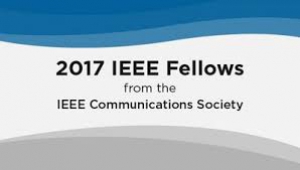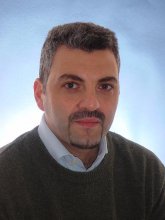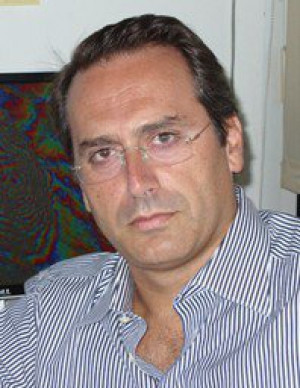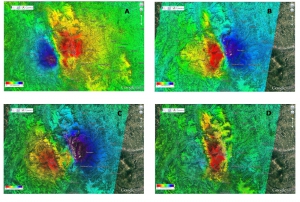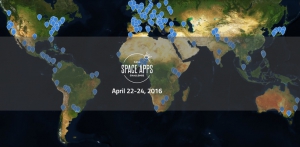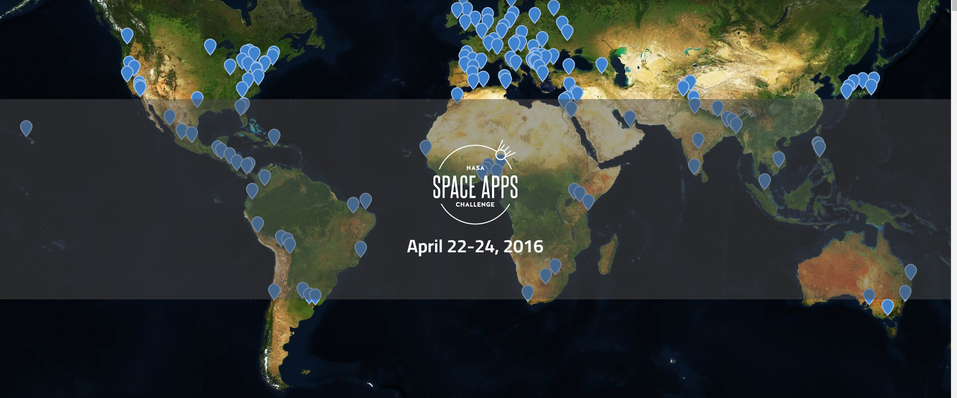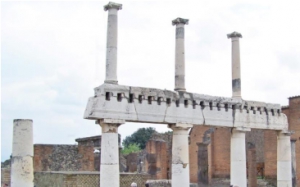
Maria Consiglia Rasulo
Gianfranco Fornaro, Senior Researcher at IREA, has been elevated to Fellow by IEEE for his for contributions to SAR processing in differential interferometry and tomography. The Fellow grade will be effective by 1 January 2017.
IEEE, “the Institute of Electrical and Electronics Engineers”, is the world's largest technical professional organization dedicated to advancing technology for the benefit of humanity. IEEE has more than 420,000 members in over 160 countries and publishes a third of the world’s technical literature in electrical engineering, computer science, and electronics.
The prestigious elevation to the highest grade of membership in the IEEE is reserved, following a rigorous evaluation procedure, to IEEE members that have contributed through extraordinary accomplishments to the advancement or application of engineering, science, and technology, bringing the realization of significant value to society.

Riccardo Lanari, director of IREA, has been announced as the recipient of the 2017 Christiaan Huygens Medal, one of the prizes that the European Geosciences Union (EGU) awards each year to eminent scientists for their outstanding research contribution to the Earth, planetary and space sciences.
In particular, the Christiaan Huygens Medal rewards innovations, discoveries, or relevant contributions that have led to significant progress in the area of "Geosciences Instrumentation and Data Systems".
The prize will be awarded at the EGU 2017 General Assembly, which will take place in Vienna on 23–28 April.
The study of ground deformation and seismic sources, now focused on the 30 October 2016 earthquake, is enriched with new important results obtained from the processing of radar images collected from the Sentinel-1 constellation along ascending and descending orbits
Thanks to the new radar images, acquired on 1 November 2016 from ascending and descending orbits by the (C-band) sensors of the Sentinel-1 constellation of the Copernicus European Programme, the processing performed by CNR-IREA using the differential radar interferometry technique has now revealed the surface deformation related to the earthquake, in all its extension (about 1100 square kilometers) and complexity.
In particular, by combining the deformation maps obtained by the Sentinel-1 ascending and descending acquisitions (Figure 1A and Figure 1B, respectively) it is possible to estimate both the vertical and east-west displacement components. Two large horizontal deformation lobes are clearly visible (see Figure 1C): the first is centered approximately in the Montegallo zone and exhibits an eastward movement (with a maximum deformation of about 40 cm), the latter is centered in the area of Norcia with westward deformation (with a maximum displacement of about 30 cm).
Figure 1 Results of the analyses carried out with Sentinel-1 radar data of the Copernicus Programme through the differential radar interferometry technique: on the top the two co-seismic deformation maps (in the radar line of sight) are presented, obtained from ascending and descending orbits (Panel A and B, respectively) starting from the Sentinel-1 data acquired on 10.26.2016 (pre-event images) and 11.01.2016 (post-event images); on the bottom the maps of the east-west (Panel C) and vertical (Panel D) components of surface deformations are shown, obtained by jointly exploiting the ascending (South-North) and descending (North-South) passages. The red star represents the epicenter of the earthquake of 30 October 2016, the white ones are the epicenters of the events of 24 August and 26 October 2016.
It is also evident a significant vertical deformation (Figure 1D) with a strong subsidence pattern down to 60 cm in the area of Castelluccio (already retrieved from previous analysis of Sentinel-1 data), and an uplift of about 12 cm in correspondence to the area of Norcia. It is worth noting that the deformation pattern related to the area of Norcia was already partially retrieved through the analysis carried out by jointly using the first Sentinel-1 data and those provided by the COSMO-SkyMed constellation (X-band), which was developed by the Italian Space Agency in cooperation with the Italian Ministry of Defense.
Finally, it is pointed out that, due to the considerable amount of the occurred deformation, it is reasonable to assume that the detected displacements are underestimated up to 30%. However, these effects will be corrected thanks to the exploitation of new already planned images that will be acquired in the next coming days, especially those collected by the radar sensor (L-band) onboard the Japanese satellite ALOS 2.
The activity is coordinated by the Italian Department of Civil Protection (DPC) and is performed by a research team of the Institute for Electromagnetic Sensing of the Environment of the National Research Council (CNR-IREA in Naples) and the National Institute of Geophysics and Volcanology (INGV), which are centers of competence in the satellite data processing and seismology sectors, respectively, with the support of the Italian Space Agency (ASI).
The Copernicus programme is led by the European Commission. The European Space Agency is in charge of developing the Sentinel satellites; ESA also operates the two Sentinel-1 satellites.
Publications in journals: 2010, 2011, 2012, 2013, 2014, 2015
-
Valente A, Sathyendranath S, Brotas V, Groom S, Grant M, Taberner M, Antoine D, Arnone R, Balch WM, Barker K, Barlow R, Belanger S, Berthon JF, Besiktepe S, Brando V, Canuti E, Chavez F, Claustre H, Crout R, Frouin R, Garcia-Soto C, Gibb SW, Gould R, Hooker S, Kahru M, Klein H, Kratzer S, Loisel H, McKee D, Mitchell BG, Moisan T, Muller-Karger F, O'Dowd L, Ondrusek M, Poulton AJ, Repecaud M, Smyth T, Sosik HM, Twardowski M, Voss K, Werdell J, Wernand M, Zibordi G, “A compilation of global bio-optical in situ data for ocean-colour satellite applications”, Earth System Science Data, Vol. 8 (1), pp 235-252.
-
Bevacqua MT, Scapaticci R, "A compressive sensing approach for 3d breast cancer microwave imaging with magnetic nanoparticles as contrast agent “, IEEE Transactions on Medical Imaging, Vol. 35 (2), pp 664-673.
-
De Novellis V, Castaldo R, Lollino P, Manunta M, Tizzani P, “Advanced three-dimensional finite element modeling of a slow landslide through the exploitation of DInSAR measurements and in situ surveys”, Remote Sensing, Vol. 8 (8), doi:10.3390/rs8080670.
-
Borgogno-Mondino E, Lessio A, Gomarasca MA, “A fast operative method for NDVI uncertainty estimation and its role in vegetation analysis”, European Journal of Remote Sensing, Vol 49, pp 137-156.
-
Minardo A, Bernini R, Zeni L, “Analysis of SNR penalty in Brillouin optical time-domain analysis sensors induced by laser source phase noise”, Journal of Optics, Vol. 18 (2), doi:10.1088/2040-8978/18/2/025601.
-
Pepe A, Solaro G, Calò F, Dema C, “A Minimum Acceleration Approach for the Retrieval of Multiplatform InSAR Deformation Time Series”, IEEE Journal of Selected Topics in Applied Earth Observations and Remote Sensing, Vol. 9 (8), pp 3883-3898.
-
Bellizzi G, “A New Formulation for the Radiation Operator: Application to the Fast Computation of the Singular Value Decomposition”, IEEE Transactions on Antennas and Propagation, Vol. 64 (8), pp 3478-3486.
-
Di Donato L, Palmeri R, Sorbello G, Isernia T, Crocco L, “A New Linear Distorted-Wave Inversion Method for Microwave Imaging via Virtual Experiments”, IEEE Transactions on Microwave Theory and Techniques, Vol 64 (8), pp 2478-2488.
-
Loperte A, Soldovieri F, Palombo A, Santini F, Lapenna V, “An integrated geophysical approach for water infiltration detection and characterization at Monte Cotugno rock-fill dam (southern Italy)”, Engineering Geology, Vol. 211, pp 162-170.
-
Punzo M, Lanciano C, Tarallo D, Bianco F, Cavuoto G, De Rosa R, Di Fiore V, Cianflone G, Dominici R, Iavarone M, Lirer F, Pelosi N, Giordano L, Ludeno G, Natale A, Marsella E, “Application of X-Band Wave Radar for Coastal Dynamic Analysis: Case Test of Bagnara Calabra (South Tyrrhenian Sea, Italy)”, Journal of Sensors, Volume 2016, 2016, doi:10.1155/2016/6236925.
-
Azar R, Villa P, Stroppiana D, Crema A, Boschetti M, Brivio PA, “Assessing in-season crop classification performance using satellite data: A test case in Northern Italy”, European Journal of Remote Sensing, Vol. 49, pp 361-380.
-
Zinno I, Mossucca L, Elefante S, De Luca C, Casola V, Terzo O, Casu F, Lanari R, “Cloud computing for earth surface deformation analysis via spaceborne radar imaging: A case study”, IEEE Transactions on Cloud Computing, Vol. 4 (1), pp 104-118.
-
Gennarelli G, Vivone G, Braca P, Soldovieri F, Amin MG, “Comparative Analysis of Two Approaches for Multipath Ghost Suppression in Radar Imaging”, IEEE Geoscience and Remote Sensing Letters, Vol 13 (9), pp 1226-1230.
-
Solaro G, De Novellis V, Castaldo R, De Luca C, Lanari R, Manunta M, Casu F, “Coseismic fault model of Mw 8.3 2015 Illapel earthquake (Chile) retrieved from multi-orbit Sentinel1-A DInSAR measurements”, Remote Sensing, Vol. 8 (4), doi:10.3390/rs8040323.
-
Gómez-Enri J, Scozzari A, Soldovieri F, Coca J, Vignudelli S, “Detection and characterization of ship targets using CryoSat-2 altimeter waveforms”, Remote Sensing, Vol. 8 (3), doi:10.3390/rs8030193.
-
Euillades LD, Euillades PA, Riveros NC, Masiokas MH, Ruiz L, Pitte P, Elefante S, Casu F, Balbarani S, “Detection of glaciers displacement time-series using SAR”, Remote Sensing of Environment, Vol. 184, pp 188-198.
-
Greco F, Currenti G, Palano M, Pepe A, Pepe S, "Evidence of a shallow persistent magmatic reservoir from joint inversion of gravity and ground deformation data: The 25-26 October 2013 Etna lava fountaining event”, Geophysical Research Letters, Vol. 43 (7), pp 3246-3253.
-
Soldovieri F, Gennarelli G, “Exploitation of ubiquitous Wi-Fi devices as building blocks for improvised motion detection systems”, Sensors, Vol. 16 (3), doi:10.3390/s16030307.
-
Bevacqua M, Crocco L, Donato LD, Isernia T, Palmeri R, “Exploiting sparsity and field conditioning in subsurface microwave imaging of nonweak buried targets”, Radio Science, Vol 51 (4), pp 301-310.
-
Diao F, Walter TR, Solaro G, Wang R, Bonano M, Manzo M, Ergintav S, Zheng Y, Xiong X, Lanari R, “Fault locking near Istanbul: Indication of earthquake potential from InSAR and GPS observations”, Geophysical Journal International, Vol. 205 (1), pp 490-498.
-
Casu F, Manconi A, “Four-dimensional surface evolution of active rifting from spaceborne SAR data”, Geosphere, Vol. 12 (3), pp 697-705.
-
Fiumara V, Fusco A, Iadarola G, Matta V, Pinto IM, “Free-Space Antenna Pattern Retrieval in Nonideal Reverberation Chambers”, IEEE Transactions on Electromagnetic Compatibility, Vol. 58 (3), pp 673-677.
-
Stevanović MN, Crocco L, Djordjević AR, Nehorai A, “Higher Order Sparse Microwave Imaging of PEC Scatterers”, IEEE Transactions on Antennas and Propagation, Vol. 64 (3), pp 988-997.
-
Minardo A, Coscetta A, Bernini R, Zeni L, “Heterodyne slope-assisted Brillouin optical time-domain analysis for dynamic strain measurements”, Journal of Optics, Vol. 18 (2), doi:10.1088/2040-8978/18/2/025601.
-
Romeo S, Sannino A, Scarfì MR, Massa R, Dangelo R, Zeni O, "Lack of effects on key cellular parameters of MRC-5 human lung fibroblasts exposed to 370 mT static magnetic field”, Scientific Reports, Vol. 6, doi:10.1038/srep19398.
-
Rana FM, Adamo M, Pasquariello G, De Carolis G, Morelli S, “LG-mod: A modified local gradient (LG) method to retrieve SAR sea surface wind directions in marine coastal areas”, Journal of Sensors, Vol. 2016, doi:10.1155/2016/9565208.
-
Catapano I, Affinito A, Guerriero L, Bisceglia B, Soldovieri F, “Majolica imaging with THz waves: preliminary results”, Applied Physics A: Materials Science and Processing, Vol. 122 (5), doi:10.1007/s00339-016-0055-2.
-
Giardino C, Bresciani M, Fava F, Matta E, Brando VE, Colombo R, “Mapping submerged habitats and mangroves of Lampi Island Marine National Park (Myanmar) from in situ and satellite observations”, Remote Sensing, Vol. 8 (1), doi:10.3390/rs8010002.
-
Busetto L, Ranghetti L, “MODIStsp: An R package for automatic preprocessing of MODIS Land Products time series”, Computers and Geosciences, Vol. 97, pp 40-48.
-
Campos-Taberner M, García-Haro FJ, Confalonieri R, Martínez B, Moreno Á, Sánchez-Ruiz S, Gilabert MA, Camacho F, Boschetti M, Busetto L, “Multitemporal monitoring of plant area index in the valencia rice district with PocketLAI”, Remote Sensing, Vol. 8 (3), doi:10.3390/rs8030202.
-
Bellizzi G, Bucci OM, Chirico G, “Numerical assessment of a criterion for the optimal choice of the operative conditions in magnetic nanoparticle hyperthermia on a realistic model of the human head”, International Journal of Hyperthermia, Vol. 32 (6), pp 688-703.
-
Bucci OM, Crocco L, Scapaticci R, Bellizzi G, “On the Design of Phased Arrays for Medical Applications”, Proceedings of the IEEE, Vol. 104 (3), pp 633-648.
-
Scifoni S, Bonano M, Marsella M, Sonnessa A, Tagliafierro V, Manunta M, Lanari R, Ojha C, Sciotti M, “On the joint exploitation of long-term DInSAR time series and geological information for the investigation of ground settlements in the town of Roma (Italy)”, Remote Sensing of Environment, Vol 182, pp 113-127.
-
Iero DAM, Crocco L, Isernia T, "On the Role and Choice of Source Polarization in Time-Reversal Focusing of Vector Fields”, IEEE Antennas and Wireless Propagation Letters, Vol. 15, pp 214-217.
-
Grimaldi IA, Testa G, Persichetti G, Loffredo F, Villani F, Bernini R, “Plasma functionalization procedure for antibody immobilization for SU-8 based sensor “, Biosensors and Bioelectronics, Vol. 86, pp 827-833.
-
Di Martino G, Iodice A, Natale A, Riccio D, “Polarimetric Two-Scale Two-Component Model for the Retrieval of Soil Moisture under Moderate Vegetation via L-Band SAR Data”, IEEE Transactions on Geoscience and Remote Sensing, Vol. 54 (4), pp 2470-2491.
-
Cherukuru N, Davies PL, Brando VE, Anstee JM, Baird ME, Clementson LA, Doblin MA, “Physical oceanographic processes influence bio-optical properties in the Tasman Sea”, Journal of Sea Research, Vol. 110, pp 1-7.
-
Gennarelli G, Ludeno G, Soldovieri F, “Real-time through-wall situation awareness using a microwave doppler radar sensor”, Remote Sensing, Vol. 8 (8), doi:10.3390/rs8080621.
-
Imperatore P, Pepe A, Lanari R, "Spaceborne Synthetic Aperture Radar Data Focusing on Multicore-Based Architectures”, IEEE Transactions on Geoscience and Remote Sensing, Vol. 54 (8), pp 4712-4731.
-
Perna S, Esposito C, Amaral T, Berardino P, Jackson G, Moreira J, Pauciullo A, Junior EV, Wimmer C, Lanari R, “The InSAeS4 airborne X-band interferometric SAR system: A first assessment on its imaging and topographic mapping capabilities”, Remote Sensing, Vol. 8 (1), doi:10.3390/rs8010040.
-
Brando VE, Lovell JL, King EA, Boadle D, Scott R, Schroeder T, “The potential of autonomous ship-borne hyperspectral radiometers for the validation of ocean color radiometry data”, Remote Sensing, Vol. 8 (2), doi:10.3390/rs8020150.
-
Gennarelli G, Solimene R, Soldovieri F, Amin MG, "Three-Dimensional Through-Wall Sensing of Moving Targets Using Passive Multistatic Radars”, IEEE Journal of Selected Topics in Applied Earth Observations and Remote Sensing, Vol. 9 (1), pp 141-148.
-
Arcaini P, Bordogna G, Ienco D, Sterlacchini S, “User-driven geo-temporal density-based exploration of periodic and not periodic events reported in social networks”, Information Sciences, Vol 340-341, pp 122-143.
-
Persichetti G, Bernini R, “Water monitoring by optofluidic Raman spectroscopy for in situ applications”, Talanta, Vol. 155, pp 145-152.
Naples is again among the 158 cities of the world in which the fifth International Space Apps Challenge, the big event sponsored by NASA, which will take place on April 23 and 24 at the Faculty of Engineering in Via Nuova Agnano 11.
Thanks to the organization supported by IREA, Department of Industrial Engineering, University of Naples Federico II, and US Consulate General for Southern Italy, many young people will have an opportunity to participate in an exciting global event and contribute their projects for one of the most prestigious institutions in the world such as NASA.
The International Space Apps Challenge is an event in which teams of students, technologists, scientists, designers, entrepreneurs, or simply enthusiasts of science and technology, work together and collaborate for 48 hours in various cities in the world to design innovative solutions to global challenges on Earth and in space.
The first Space Apps Challenge took place in 2012 among 25 cities around the world. Over the years, the event has involved a growing number of cities and participants. In 2015, it counted 13,918 participants in 133 cities globally, with 949 projects, and became the biggest hackathon ever made. For the first time, Napoli became part of this great event in 2015 and continues the active participation also for the current year.
Registration has already been started and it is absolutely free and open to everyone. At the end of the event, on Sunday afternoon, April 24, two teams will be selected as local winners. In addition, one People's Choice will be announced on the Space Apps Event. Among all the local winners, NASA will select the global winners in each of the five finalist categories: Best Use of Data, Best Use of Hardware, Best Mission Concept, Galactic Impact and Most Inspirational.
For information download the brochure:
For registration and detailed information follow the link: https://2016.spaceappschallenge.org/locations/napoli-italy
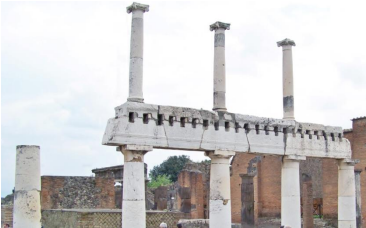
In the fascinating setting of Pompeii archaeological area, the school "Geophysics and Remote Sensing for Archaeology" will be held from 9 to 13 May 2016.
The course is organised by two Institutes of the National Research Council of Italy, i.e. CNR-IBAM and CNR-IREA, and Soprintendenza Speciale Beni Archeologici Pompei, Ercolano e Stabia.
The School aims at giving the opportunity to scholars, Ph.D. students, researchers and specialists in Geophysics, Remote Sensing and Archaeology to deepen their knowledge and expertise with geophysical and remote sensing techniques for archaeology and cultural heritage documentation and management. The school consists of lectures and on-field practical work.
For more information about contents and timing of courses, registration and Participation download the brochure:
Continental scale mapping capabilities of Sentinel-1 sensor: the 12-days InSAR coherence over Europe
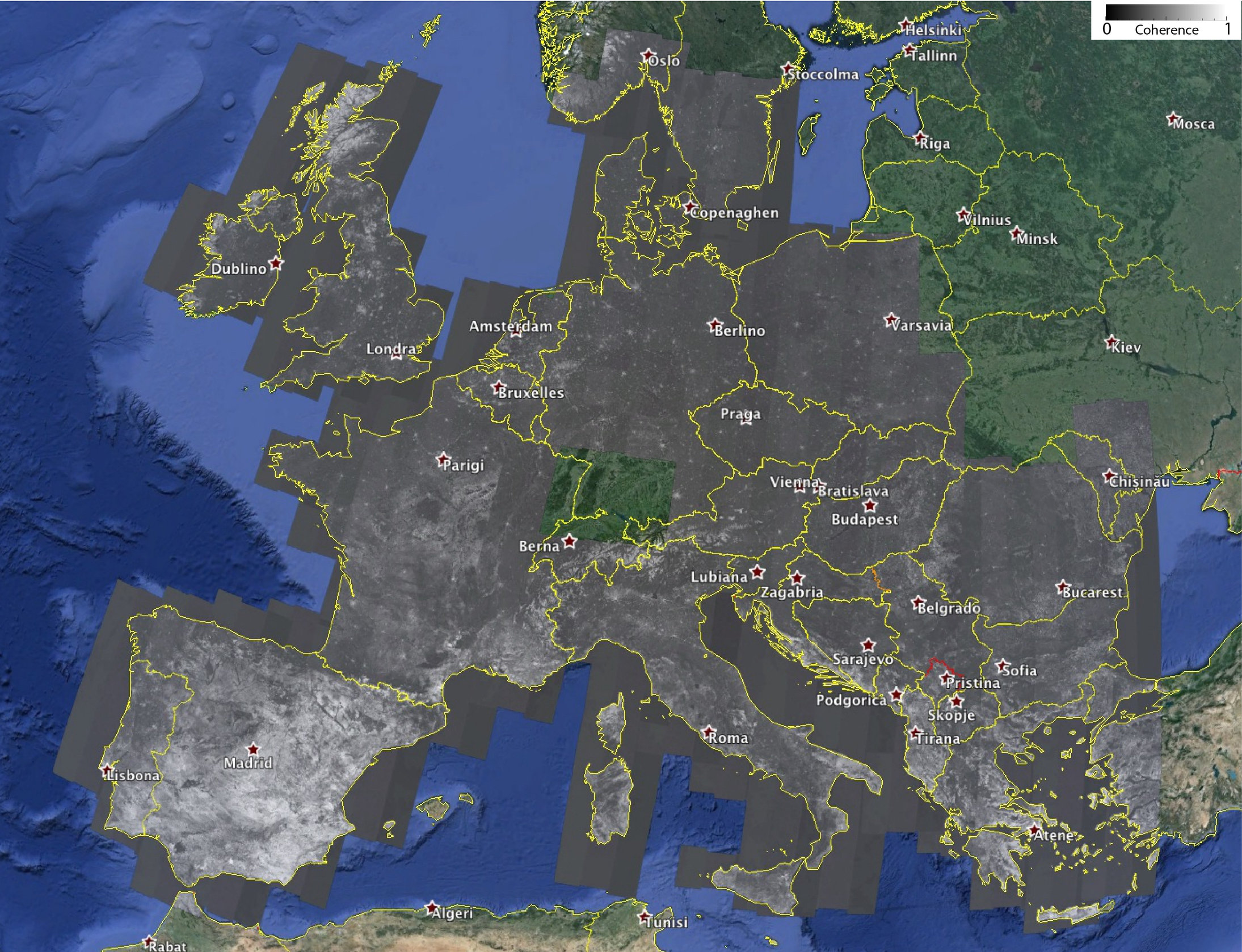 Sentinel-1 is the first satellite of the Copernicus program and is equipped with a Synthetic Aperture Radar (SAR) sensor that is able to provide day-night acquisitions nearly over the whole World. The Sentinel-1 operational mode on land is the so-called Interferometric Wide Swath (IWS), which guarantees the Earth’s global coverage with a revisit time of 12 days, thus making Sentinel-1 as a powerful system for surface displacement monitoring at global scale through Interferometric SAR (InSAR) technique.
Sentinel-1 is the first satellite of the Copernicus program and is equipped with a Synthetic Aperture Radar (SAR) sensor that is able to provide day-night acquisitions nearly over the whole World. The Sentinel-1 operational mode on land is the so-called Interferometric Wide Swath (IWS), which guarantees the Earth’s global coverage with a revisit time of 12 days, thus making Sentinel-1 as a powerful system for surface displacement monitoring at global scale through Interferometric SAR (InSAR) technique.
In this context, scientists of IREA-CNR processed 380 Sentinel-1 imagery, acquired over Europe during the June-July 2015 period and coupled in 190 12-days interferometric pairs with 2 looks in azimuth and 10 in range, with the final aim to analyse the InSAR characteristics of the European Continent. Such a study permits to assess the Sentinel-1 InSAR performances as well as to have an idea of the expected InSAR measurements quality over the Europe. As a result, in Figure 1 the 12-days Interferometric Coherence map of almost the entire Europe is shown; note that white and black areas correspond to high (close to 1) and low (close to 0) coherence values, respectively.
“This work demonstrates the high capabilities of Sentinel-1 system for surface displacement detection at global scale”, states Francesco Casu, researcher at IREA-CNR, “and represents the first step towards the generation of continental scale Earth’s surface deformation maps and time series”.
This study has been carried out by exploiting the automated and unsupervised IREA-CNR processing tools integrated within the Geohazards Exploitation Platform (GEP), an ESA initiative for fostering the creation of a novel and dynamic scientific environment where are at user disposal, at the same time and in the same place, data, computing facilities and processing tools.
“The GEP environment, that hosts the IREA-CNR InSAR tools freely accessible to the scientific community”, says Michele Manunta, researcher at IREA-CNR, “permits researchers to change the way they do science, opening new scenarios in terms of data access, processing capacity and result sharing, thus fostering the creation of knowledge”. Within the GEP, the main IREA-CNR task is to set-up an automated service for the systematic generation and update of SBAS-InSAR displacement time series originated from Sentinel-1 data.
This study, realized with the support of the ESA GEP, TEP-QW and G-POD projects, as well as of the Italian Department of the Civil Protection, paves the way for the implementation, in the near future, of new services and products addressed to the scientific community (as for instance the EPOS one), as well as to the National Departments of Civil Protection.
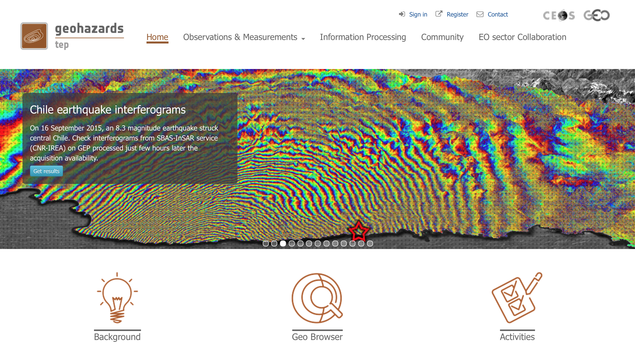 In the frame of the next AGU 2015 Fall meeting IREA-CNR organized a training event on “Training on the SBAS-DInSAR web tool for Earth surface deformation analysis through the ESA Geohazard Exploitation Platform”.
In the frame of the next AGU 2015 Fall meeting IREA-CNR organized a training event on “Training on the SBAS-DInSAR web tool for Earth surface deformation analysis through the ESA Geohazard Exploitation Platform”.
The event originates in the context of space-borne geodetic techniques, and will focus on Differential Synthetic Aperture Radar Interferometry (DInSAR), which has already demonstrated its capability to measure surface displacements in different conditions and scenarios. In particular, the advanced DInSAR time series processing methods, as for instance the Small BAseline Subset (SBAS) one that allows studying both the spatial and temporal variability of the surface displacements, have proven to be particularly suitable in different contexts, as for natural hazards (volcanoes, earthquakes and landslides) and human-induced deformation (subsidence due to aquifer exploitation, mining operations, and building of large infrastructures).
Recently, the IREA-CNR implementation of the SBAS algorithm has been fully integrated (http://goo.gl/KE9Qna) within the ESA's Grid Processing on Demand (G-POD) environment, which is part of the Geohazards Thematic Exploitation Platform (GEP) of ESA. The GEP is an R&D activity on the ESA EO ground segment to demonstrate the benefit of new techniques for large scale processing of EO data. This encompasses both user driven on-demand processing as well as systematic processing, to address common information needs of the geohazards community as a whole. Accordingly, the GEP is sourced with data, computing resources and processing tools, including SBAS-DInSAR, relevant to the geohazard theme.
The integration of the SBAS-DInSAR algorithm within GEP resulted in a web-based tool freely available to the scientific community. This tool allows users to process, from their own laptops, the European SAR data archives (ERS, ENVISAT and Sentinel-1) for obtaining surface displacement maps and time series in a completely unsupervised way, without caring about data download and processing facility procurements.
More information about the training event at https://www.eventbrite.com
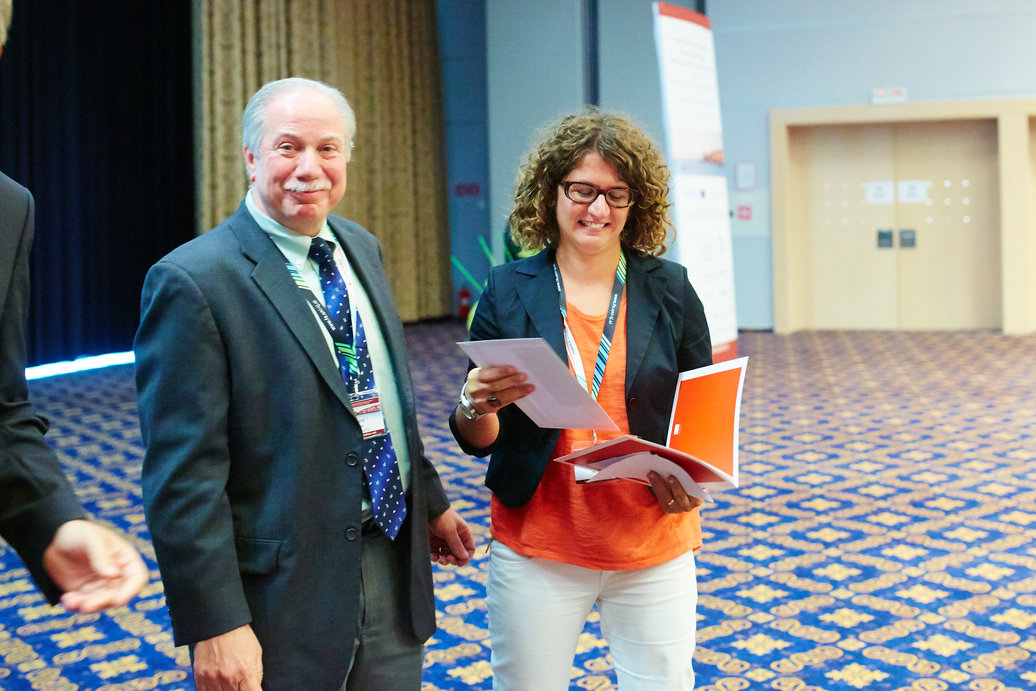 During the "1st World Congress on Electroporation and Pulsed Electric Fields in Biology, Medicine and Food & Environmental Technologies", which was held in in Portoroz (Slovenia) from 5 to 10 September 2015, Dr. Stefania Romeo, a research fellow at IREA in Naples, received the second prize in the category Medicine and Biology of the Young Investigator Competition reserved to young researchers under 35.
During the "1st World Congress on Electroporation and Pulsed Electric Fields in Biology, Medicine and Food & Environmental Technologies", which was held in in Portoroz (Slovenia) from 5 to 10 September 2015, Dr. Stefania Romeo, a research fellow at IREA in Naples, received the second prize in the category Medicine and Biology of the Young Investigator Competition reserved to young researchers under 35.
The work presented, entitled "Electroporation of a bladder cancer cell line in presence of calcium: efficacy dependence on electric field strength and calcium concentration" (authors: Stefania Romeo, Emilie L. Hansen, Stine K. Frandsen, Julie Gehl), deals with the use of intense pulsed electric fields to facilitate the massive entry of calcium into the tumor cells so as to induce death. This technique is very promising in the field of cancer therapy, being the calcium nontoxic and cheaper than the commonly used drugs for electrochemotherapy.
The methodology was used for the first time by the group of Dr. Julie Gehl from the Department of Oncology at the University of Copenhagen, with whom Dr. Romeo worked in May 2014 in the framework of a short term scientific mission funded by COST TD1104 (European Network for the development of Electroporation-based Technologies and Treatments). During the period of co-operation an experimental work with subsequent analysis of data was done, to optimize some parameters of the technique (electric field intensity and concentration of calcium) in order to increase the efficiency of the treatment.
The results of this work have been published in the journal Plosone http://journals.plos.org/plosone/article?id=10.1371/journal.pone.0122973
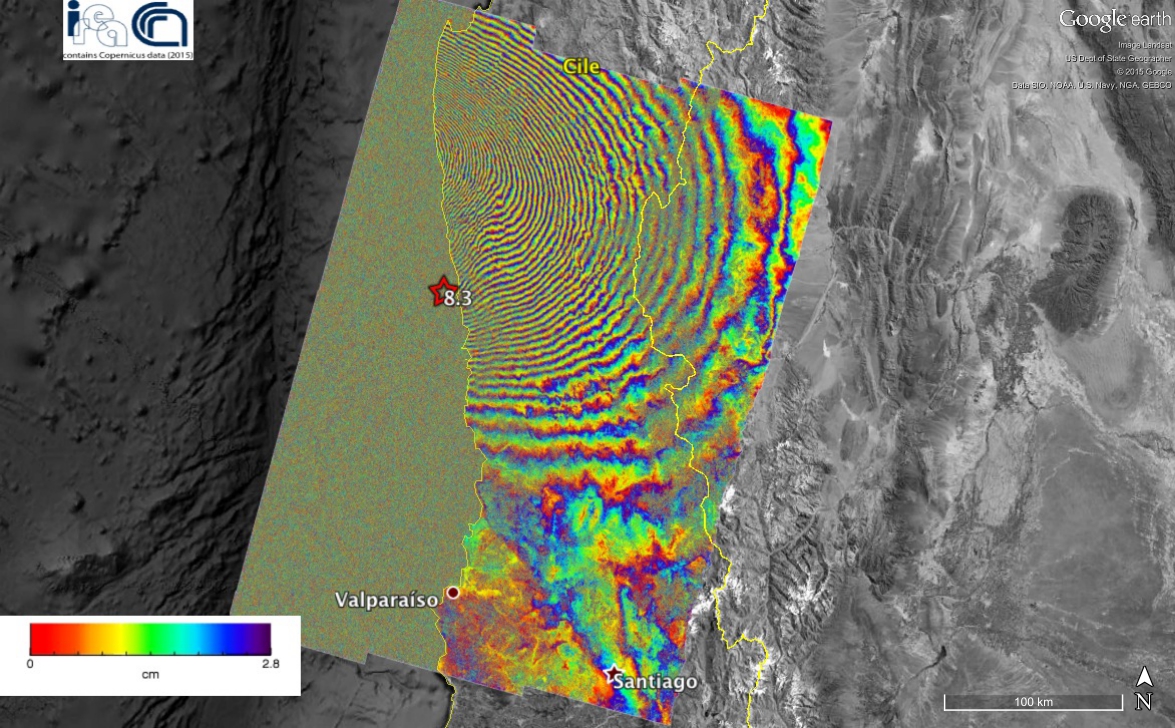 An earthquake of magnitude 8.3 struck the central region of Chile, 46 km west of the city of Illapel, at 22:54:33 (UTC) on September 16, 2015. The area is considered one of the regions at highest seismic risk in the world. The seismic activity in the region is caused by the convergence of the Nazca and South America plates with a relative movement between the two plates of about 74 mm / year (source: USGS).
An earthquake of magnitude 8.3 struck the central region of Chile, 46 km west of the city of Illapel, at 22:54:33 (UTC) on September 16, 2015. The area is considered one of the regions at highest seismic risk in the world. The seismic activity in the region is caused by the convergence of the Nazca and South America plates with a relative movement between the two plates of about 74 mm / year (source: USGS).
The earthquake is the result of a movement along a reverse fault dipping eastward, having a length of approximately 250 km and a width of about 100 km.
Via differential radar interferometry, researchers at the Institute for Electromagnetic Sensing of the Environment have studied the field of surface deformation caused by the quake. In particular, they used the data acquired on July 31 and September 17, 2015 (immediately after the event) by the European satellite Sentinel-1A, that have made it possible to generate the displacement map (interferogram) shown in the figure. Each color band (fringe) indicates a ground shift of approximately 2.8 centimeters, with a maximum deformation of about 140 centimeters.
The activity has been conducted as part of the agreement between IREA-CNR and the Italian Department of Civil Protection (DCP), the TEP-QuickWin project of the European Space Agency (ESA) and the project "High Technological Infrastructure for Integrated Monitoring of Climate and Environment" (I-AMICA) funded by the Italian Ministry of Education, University and Research as part of the National Operational Programme (PON). The presented results contain Copernicus data 2015.


